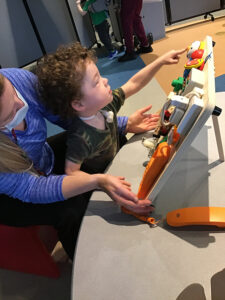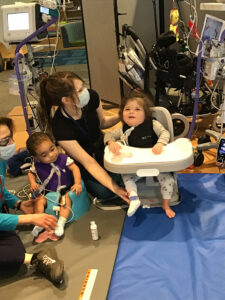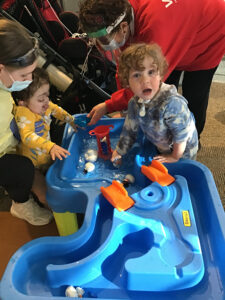There’s no place like Ranken Jordan Pediatric Bridge Hospital. That’s proven once again after the hospital recently launched an innovative program called OZ, short for the Optimization Zone, to ensure children in the sensitive developmental ages of 0-5 spend more time out of their beds engaged in play and social activities.
The OZ program is unique to the country, says Claire Wallace, PhD, a pediatric psychologist at Ranken Jordan.
“The need for this type of program has been clear to us for a long time. The lockdowns and isolation during the pandemic made it even more obvious how necessary it was. Fewer visitors and volunteers made for even fewer opportunities to tend to our patients’ developmental needs.”
Where There’s a Will, There’s a Way
Because a growing number of children with medically complex needs can’t go home safely, they tend to stay in the hospital for many months and sometimes years—often during a critical developmental window.
Health care studies show that up to 85% of kids in the 0-5 age range who are hospitalized long-term have severe developmental delays. “Giving these kids more exposure to developmental opportunities like the OZ program will help close the gap,” Dr. Wallace says.
Nick Holekamp, MD, vice president and chief medical officer at Ranken Jordan, explains that Ranken Jordan has a higher percentage than ever of children—30-40%—who are medically ready to go home but can’t because the home situation isn’t ready, a problem that mirrors a nationwide trend.
“Children are stuck in this situation and get farther behind developmentally.” he says. “The OZ program is designed to slow or make up for developmental delays that are so common in these children.”
 The OZ initiative grew out of a larger Ranken Jordan committee called CAN DO, the Committee to Assure Neurodevelopmental Optimization. This committee is charged with creating enriching neurodevelopmental programs for patients in the crucial early childhood developmental window between ages 0-5. About half of children at Ranken Jordan are in this age group.
The OZ initiative grew out of a larger Ranken Jordan committee called CAN DO, the Committee to Assure Neurodevelopmental Optimization. This committee is charged with creating enriching neurodevelopmental programs for patients in the crucial early childhood developmental window between ages 0-5. About half of children at Ranken Jordan are in this age group.
“Our responsibility is to be good stewards of development while also keeping children alive,” Dr. Wallace explains. “We toe the line to keep our kids safe but we also cannot ignore their developmental needs. Kids have no business being in bed all day and need a light, dynamic space to land. That’s what OZ provides.”
In a previous hospital, Dr. Wallace recalls working in a neonatal intensive care unit setting where a 2-year-old child only left his room once during a year except to leave for procedures. She and her colleagues are ensuring that doesn’t happen at Ranken Jordan despite the challenges and the time commitment it takes to get kids out of their rooms with ventilators and other essential medical equipment.
“I think the reason a program like OZ isn’t commonly provided is because it’s hard to do,” Dr. Wallace says. “More children have tracheostomies and ventilators than ever. These are medically fragile, complex kids who need a lot of equipment, support, and supervision. They are scary to handle. They have high medical needs. But they also still have high developmental needs. Often these fall by the wayside in traditional hospital settings. We want these kids to spend most of their waking hours out of their rooms.”
Experienced in caring for children with a complex mix of medical and developmental needs, the Ranken Jordan team was determined to find solutions to every challenge to make the OZ program successful.
A key part of that process was working closely with the infection prevention team to put precautions in place to keep children in the program safe from COVID-19 and other viruses and infections.
For more than 20 years, Dr. Holekamp has been the “wizard” behind Ranken Jordan’s focus on getting children out of bed to play and socialize while also keeping them safe through a care model he pioneered called “Care Beyond the Bedside.” He is as passionate as ever about addressing children’s developmental needs and sees OZ as the next logical step.
“For years, we’ve gotten kids out of bed safely at Ranken Jordan despite trachs, ventilators and other equipment. We have extensive safety measures in place and go above and beyond to keep kids safe while helping them get out and play.”
Dr. Holekamp witnessed firsthand the developmental impact caused by the lengthy pandemic. “Isolation and separation can be helpful to limit infections except the benefit is blown out of the water by the detriment we’re doing by isolating a child during a key developmental window. Keeping kids safe is our primary responsibility. Development is also vital. We can do both. Our pilot showed it can be done.”

Dreams Do Come True
Dr. Wallace says OZ gives children enriched, free-play experiences where they can explore and do what they want with access to toys and team member support. This free play allows children to develop their imaginations, independence and social skills. Children also have music, art and movement opportunities in OZ.
Children attend the OZ program in a bright, open space facing the outdoor playground at Ranken Jordan. In many ways, the space looks like a traditional preschool setting with low tables, mats, toys and a water table. But it also has special accommodations for children with high medical needs. That includes multiple outlets to plug in medical equipment, ventilators, suction machines, medical strollers and adapted seating arrangements to allow children to participate with no obstacles.
The team strives to get children outside every day, even in the snow. “Through OZ, we will use our outside spaces even more,” Dr. Wallace says. “One day we took the kids outside on the baseball field. These kids have G-tubes, artificial airways, wireless pulse oximeters, and more, yet there they were chasing after balls, running around and learning to share. All with staff close by carrying suction machines and backpacks filled with supplies that might be needed in an emergency. Many hospitals would be terrified to do this. But this is what we’ve done safely for years and the kids thrive!”
Dr. Wallace says Ranken Jordan is committed to the OZ program. “We’re going to do it no matter what. The immediate and dramatic affect we saw in how these kids behave compels us to overcome whatever hurdles we might confront.”
The focus on play is at the heart of Ranken Jordan’s Care Beyond the Bedside model. “Kids get better by playing,” Dr. Holekamp says. “They will get better if they feel better. The foundation of everything at Ranken Jordan is ‘the more you do, the more you can do.'”
Giving Children What They Need
OZ is already making a difference for children. During the first week, a 5-year-old boy was hesitant and a little nervous to come into the OZ program area. While adults tried to cajole him, 4-year-old Lisa, who is non-verbal, waved him over to where she was playing. The little boy quickly joined in.
“Kids can engage each other better than adults,” Dr. Wallace says. “Outside of therapy time, kids can make big developmental gains by playing with their peers.”
 The team takes an individual approach to each child. Not all children can tolerate three hours of stimulation in the OZ program, Dr. Wallace explains.
The team takes an individual approach to each child. Not all children can tolerate three hours of stimulation in the OZ program, Dr. Wallace explains.
Putting Play on Center Stage
Nurses and respiratory therapists are encouraged to bring daily feedings and treatments to the children while they are in OZ rather than taking them back to their rooms for care. For example, a child with a feeding tube can have the feeding started while in circle time at OZ instead of being put in bed for it. “OZ lets kids live their lives while still getting care,” Dr. Wallace says.
Dr. Holekamp agrees. “The OZ program helps offset some of the hospital-based developmental insults that hamper their medical and social improvement. The conventional aspects of care fade to the background so that the really effective intervention – play – can take center stage.”
Every team member takes their turn working in OZ. Occupational, physical and speech therapists as well as child life specialists staff the OZ program full time on a rotating basis. Volunteers, psychologists, music therapists, nurses and respiratory therapists also participate.
“OZ is run by internal staff who have extensive experience in child development,” Dr. Wallace says. “That’s another reason this program is so impactful. Kids get the maximum developmental assistance outside formal therapy. It’s a true multidisciplinary team with someone from every direct patient care team represented.”
She adds that the OZ program demonstrates a significant organizational commitment. “We devote significant time, energy and resources to it every day. This is our mission. At every planning meeting for OZ, the team said we will figure out how to make this happen because it’s so important to the kids we take care of. There’s so much energy around this program. We all saw this as a critical element of their care.”
Dr. Holekamp was inspired by how well this program has been received. “When we were planning OZ, we asked ‘Are we crazy?’ Yet anyone who has seen this program at work is blown away. Such an obvious thing to do and yet it’s never been done before. There has been a groundswell of support. The internal excitement is hopefully a good indicator of where the medical community will be, too.”
Helping Others Follow the Road to OZ
Another important component of the OZ program is the iCare app, frequently used in childcare centers. This app allows the team to send pictures of children to their caregivers throughout the day and give them developmental updates. Dr. Holekamp believes the iCare app combined with the OZ program has the potential to help caregivers see their children differently and build confidence in caring for them.
“Many caregivers can’t be with their children at Ranken Jordan every day,” he explains. “My hope with iCare is that these caregivers can feel more connected to their kids and learn what they can do to help them progress developmentally. They’ll also be better more comfortable and better prepared when it’s finally time to take their child home.”
Dr. Wallace shares that hope. “I’m excited for parents and caregivers to see the huge developmental leaps and bounds kids can make,” she says. “They may realize their child’s medical condition is not nearly as limiting as it has been before they got here.”
The “Ranken Jordan effect” has a strong track record of igniting children’s progress. “Even before we had OZ, it was cool to see children come here from other settings, get used to the vibrant environment and stimulation here, and start to explore the world. Then their development can really take off. We call it the ‘Ranken Jordan effect.’ Now OZ ups the ante for these young patients.”
Dr. Holekamp is excited about the potential of the OZ program for children around the country. “Our Care Beyond the Bedside model and OZ might set examples for others to follow and duplicate. Thousands of kids across the country spend big chunks of their early lives in hospitals. It’s not good for them to sit in a room by themselves all day. I think a program like OZ should be part of the care we provide for all of these children. Kids need to interact with other kids socially and playfully. And I believe it helps kids get healthier faster and home sooner. Ranken Jordan is determined to show the pediatric healthcare community that playing with your friends is not just fun. It’s also really good medicine!”
We all know there’s no place like home and the goal is to get every child home with their family as soon as possible. For complicated kids who aren’t yet ready to go home and thanks to the dedicated team, compassionate care and innovative programs like OZ, there truly is no place like Ranken Jordan.

